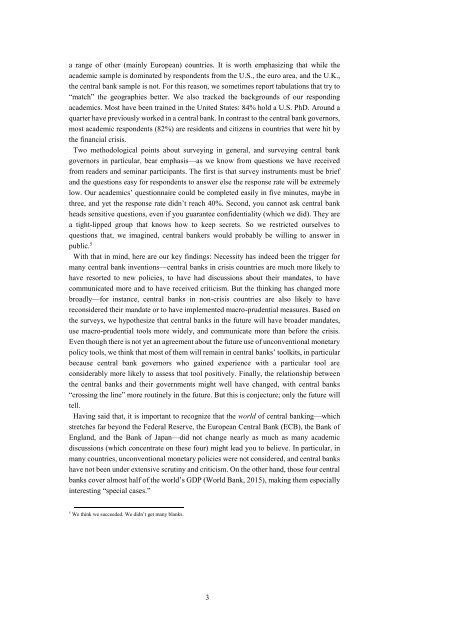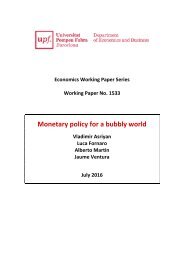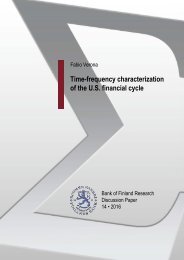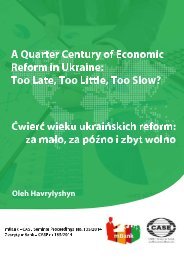Necessity as the mother of invention monetary policy after the crisis
n?u=RePEc:dnb:dnbwpp:525&r=mac
n?u=RePEc:dnb:dnbwpp:525&r=mac
You also want an ePaper? Increase the reach of your titles
YUMPU automatically turns print PDFs into web optimized ePapers that Google loves.
a range <strong>of</strong> o<strong>the</strong>r (mainly European) countries. It is worth emph<strong>as</strong>izing that while <strong>the</strong><br />
academic sample is dominated by respondents from <strong>the</strong> U.S., <strong>the</strong> euro area, and <strong>the</strong> U.K.,<br />
<strong>the</strong> central bank sample is not. For this re<strong>as</strong>on, we sometimes report tabulations that try to<br />
“match” <strong>the</strong> geographies better. We also tracked <strong>the</strong> backgrounds <strong>of</strong> our responding<br />
academics. Most have been trained in <strong>the</strong> United States: 84% hold a U.S. PhD. Around a<br />
quarter have previously worked in a central bank. In contr<strong>as</strong>t to <strong>the</strong> central bank governors,<br />
most academic respondents (82%) are residents and citizens in countries that were hit by<br />
<strong>the</strong> financial <strong>crisis</strong>.<br />
Two methodological points about surveying in general, and surveying central bank<br />
governors in particular, bear emph<strong>as</strong>is—<strong>as</strong> we know from questions we have received<br />
from readers and seminar participants. The first is that survey instruments must be brief<br />
and <strong>the</strong> questions e<strong>as</strong>y for respondents to answer else <strong>the</strong> response rate will be extremely<br />
low. Our academics’ questionnaire could be completed e<strong>as</strong>ily in five minutes, maybe in<br />
three, and yet <strong>the</strong> response rate didn’t reach 40%. Second, you cannot <strong>as</strong>k central bank<br />
heads sensitive questions, even if you guarantee confidentiality (which we did). They are<br />
a tight-lipped group that knows how to keep secrets. So we restricted ourselves to<br />
questions that, we imagined, central bankers would probably be willing to answer in<br />
public. 5<br />
With that in mind, here are our key findings: <strong>Necessity</strong> h<strong>as</strong> indeed been <strong>the</strong> trigger for<br />
many central bank <strong>invention</strong>s—central banks in <strong>crisis</strong> countries are much more likely to<br />
have resorted to new policies, to have had discussions about <strong>the</strong>ir mandates, to have<br />
communicated more and to have received criticism. But <strong>the</strong> thinking h<strong>as</strong> changed more<br />
broadly—for instance, central banks in non-<strong>crisis</strong> countries are also likely to have<br />
reconsidered <strong>the</strong>ir mandate or to have implemented macro-prudential me<strong>as</strong>ures. B<strong>as</strong>ed on<br />
<strong>the</strong> surveys, we hypo<strong>the</strong>size that central banks in <strong>the</strong> future will have broader mandates,<br />
use macro-prudential tools more widely, and communicate more than before <strong>the</strong> <strong>crisis</strong>.<br />
Even though <strong>the</strong>re is not yet an agreement about <strong>the</strong> future use <strong>of</strong> unconventional <strong>monetary</strong><br />
<strong>policy</strong> tools, we think that most <strong>of</strong> <strong>the</strong>m will remain in central banks’ toolkits, in particular<br />
because central bank governors who gained experience with a particular tool are<br />
considerably more likely to <strong>as</strong>sess that tool positively. Finally, <strong>the</strong> relationship between<br />
<strong>the</strong> central banks and <strong>the</strong>ir governments might well have changed, with central banks<br />
“crossing <strong>the</strong> line” more routinely in <strong>the</strong> future. But this is conjecture; only <strong>the</strong> future will<br />
tell.<br />
Having said that, it is important to recognize that <strong>the</strong> world <strong>of</strong> central banking—which<br />
stretches far beyond <strong>the</strong> Federal Reserve, <strong>the</strong> European Central Bank (ECB), <strong>the</strong> Bank <strong>of</strong><br />
England, and <strong>the</strong> Bank <strong>of</strong> Japan—did not change nearly <strong>as</strong> much <strong>as</strong> many academic<br />
discussions (which concentrate on <strong>the</strong>se four) might lead you to believe. In particular, in<br />
many countries, unconventional <strong>monetary</strong> policies were not considered, and central banks<br />
have not been under extensive scrutiny and criticism. On <strong>the</strong> o<strong>the</strong>r hand, those four central<br />
banks cover almost half <strong>of</strong> <strong>the</strong> world’s GDP (World Bank, 2015), making <strong>the</strong>m especially<br />
interesting “special c<strong>as</strong>es.”<br />
5<br />
We think we succeeded. We didn’t get many blanks.<br />
3








